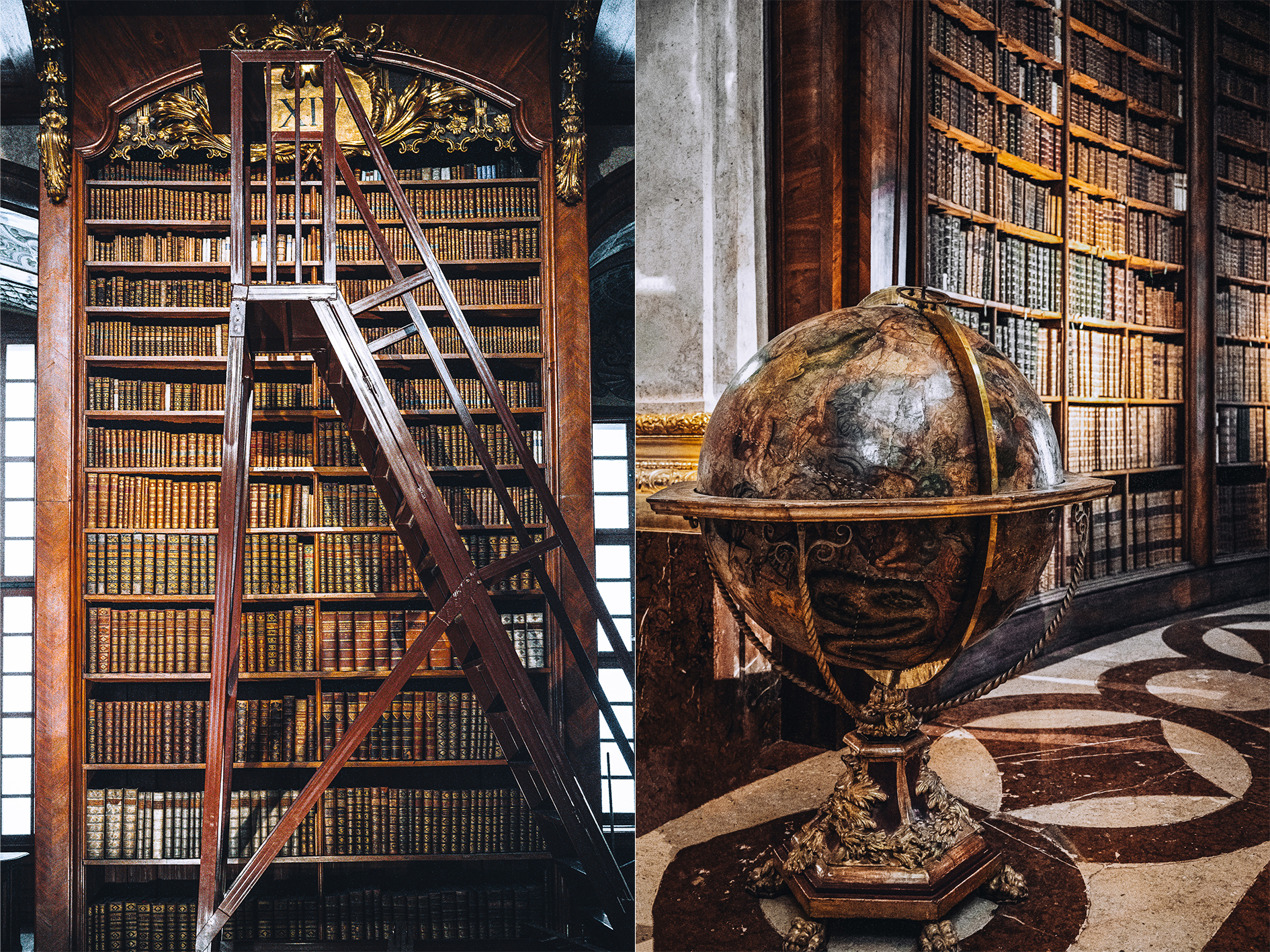After the clerk checks your ticket and opens a massive door for you to enter, enchantment unfolds. You know you are in a special, breathtakingly beautiful place. And you are not alone. Your gasp of astonishment harmonizes with the collective one of all who traverses the threshold. The next moment, an expansive “library room,” stretching nearly 80 meters, rises 20 meters above your head, slowly unveiling its grandeur. Soft, dignified light embraces colossal, ornate wooden bookcases guarded by giant mobile ladders. Marble columns topped with gilded artistry hold this baroque jewel that is crowned at its centre by a magnificent dome and numerous frescos around.
The books in this library aren’t the sole protagonists; approximately 16 statues and 12 busts of the Austro-Spanish Habsburg family, carved in marble stand around the room. Emperor Charles VI’s “Hercules Musarum” statue is prominently positioned beneath the dome, surrounded by four magnificent celestial and terrestrial Venetian globes. It is a journey back to the glory of the Habsburg, who were passionate collectors of books and manuscripts.
The Prunksaal, the central structure of the old imperial library (State Hall in English), resides at the heart of the city as part of Vienna’s Imperial Palace. In 1723, Emperor Charles VI commissioned architect Johann Bernhard Fischer von Erlach, famous for his work on Schonbrunn Palace, to construct the Court Library. This collaboration led to the creation of one of the world’s most beautiful library rooms and Europe’s largest Baroque Library house.
As a passionate admirer of books and art, I effortlessly lost myself in a magical realm of words, knowledge, culture, artistry and aesthetics.
I could easily spend an hour only gazing at the incredibly detailed ceiling paintings of the apotheosis of the Emperor by court painter Daniel Gran. He worked four years on them. I could marvel for hours at the 128 historic bookshelves and cabinets, containing 200,000 leather-bound tomes, which I could only imagine, encompass ancient philosophy, history, mythology, manuscripts, musical scores, atlases, and maps—a treasure trove of European intellectual heritage and culture. While these fragile and precious books can’t be read on-site, glass display cabinets showcase rarities from the library collection and artifacts linked to the ongoing exhibition in the Prunksaal. The hall is thoughtfully divided into 'war' and 'peace' sides, echoing the original arrangement of the books, as depicted in the wall frescoes.
Indeed, the visit might be a quick run-through since it is just one elongated room. I chose not to rush through. Even though I stepped into the library late in the day, I took the time to savour all the splendour this place has to offer right until a voice reminded all the visitors that it was time to bid farewell.
Amidst the vast knowledge within this magnificent hall, an awestruck silence is demanded.
The library’s solemn atmosphere creates both a sense of privilege and connection. As I sat on the chair in genuine admiration, it was just me, my camera and the rich history of human enlightenment. The people in the hall suddenly disappeared as I quieted down in the middle of centuries-old words and ideas that have been navigating the world, serving as "gates to the future."
Who would dare disrupt the peace of these books, mastery and timeless beauty?
(click on each image to see it in detail)
When in Vienna, I highly recommend spending time in The Austrian National Library.
If you have already been, please share your experience in the comment section.
STATE HALL OF THE AUSTRIAN NATIONAL LIBRARY
Address:
Josefsplatz 1
1010 Vienna
Website:



















The atmosphere and the art are truly splendid, Sylvia! Your presentation, through both images and words, is flawless!
ReplyDelete